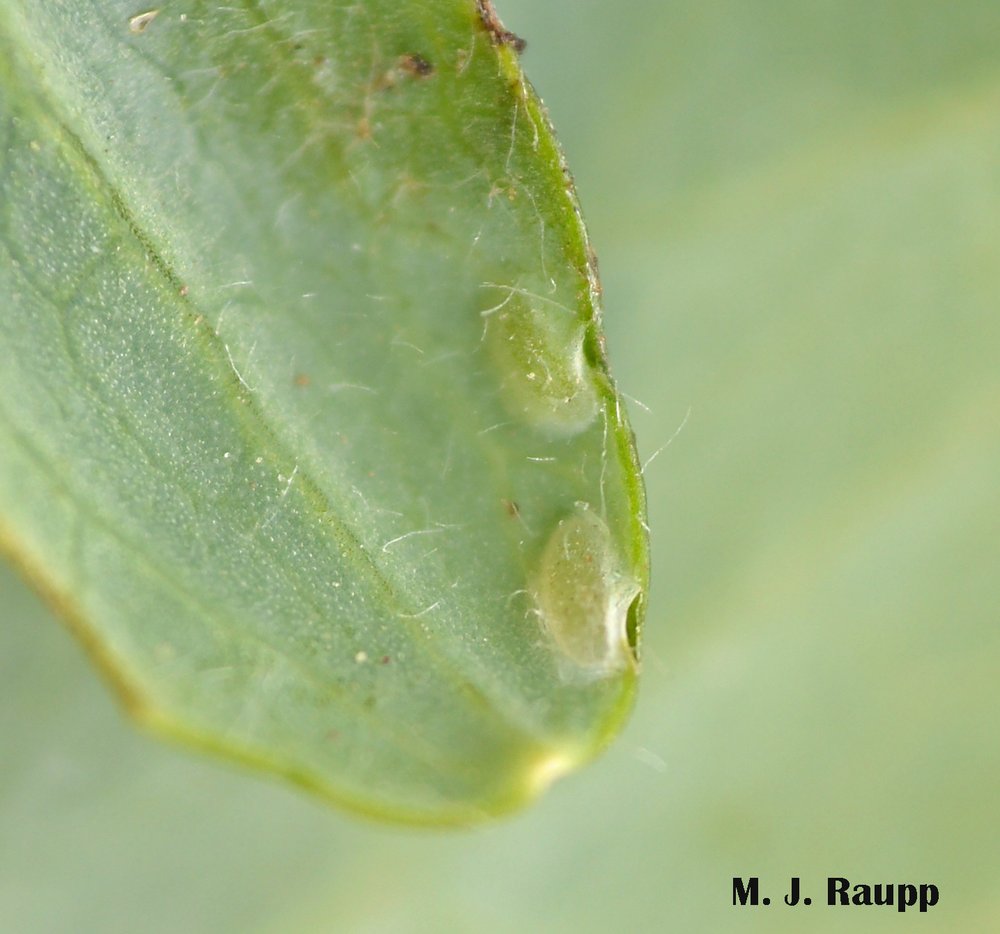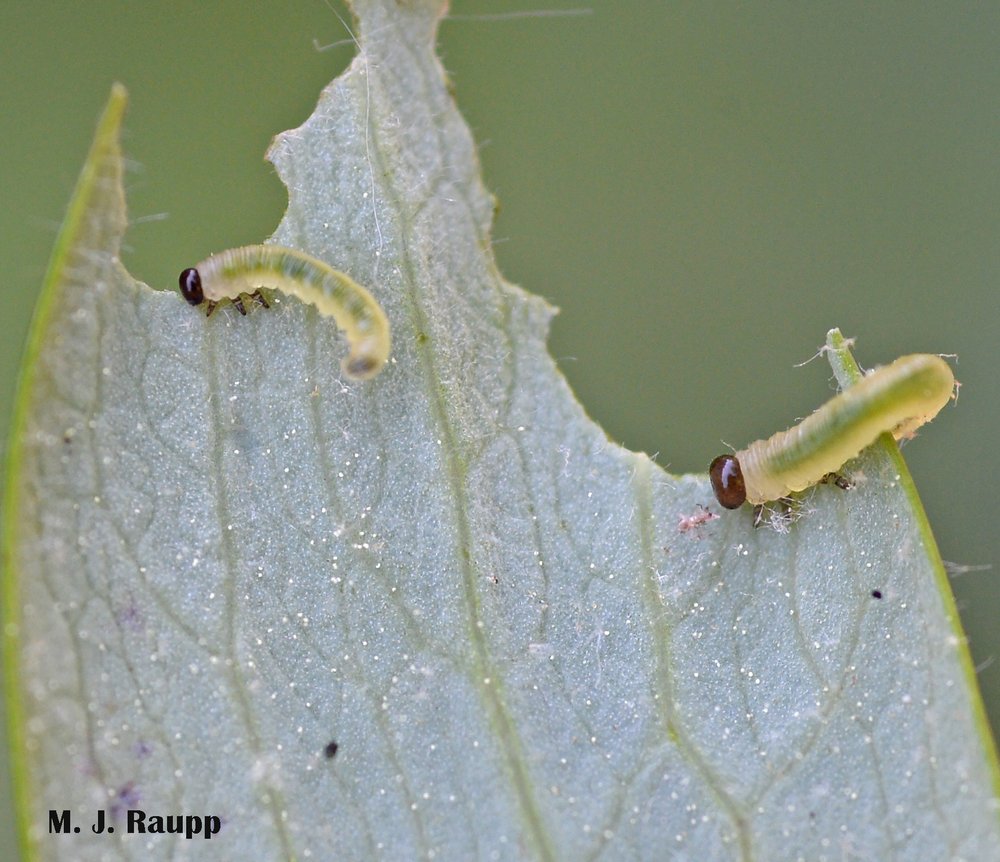Vanquished vanishing columbines: Columbine sawfly, Pristiphora rufipes

Look out columbine! That sawfly is laying eggs in your leaves.

Columbines are among the most glorious perennials found in gardens and landscapes.
On a recent visit to a spectacular residential garden in Columbia, MD, I was chagrined to see beautiful clusters of columbines denuded of leaves and reduced to spindly blossom-tipped stubs. Swarming about these unfortunate beauties were what at first appeared to be tiny black flies. Upon closer inspection the presence of four wings instead of two confirmed that these were not flies, but primitive wasps known as sawflies. Flies belong to a clan of insects, Diptera, with but one pair of wings and sawflies are part of the bee and wasp clan, Hymenoptera, with two pairs of wings.
These slits in the epidermis of a leaf hold eggs deposited by the female columbine sawfly. Eggs will soon hatch and leaf-munching larvae will begin to feed.
Why are they called sawflies? Well, not because you saw them. No, these primitive wasps bear a saw-like appendage on their abdomen used to slice leaves or stems of plants to create a pocket into which eggs are inserted. This particular non-native sawfly has roots throughout much of central Europe and was first discovered in North America in Canada, the year Surfin’ U.S.A. topped the charts in 1963. By 1983 these rascals reached upstate New York and they now occur from the eastern seaboard to the Rockies. Adult sawflies feed on a variety of foods including nectar, pollen, and other insects. Ah, but larval columbine sawflies have powerful jaws to devour the leaves of columbines.

Newly hatched columbine sawfly larvae begin their nefarious work of defoliating leaves of columbine.
Columbines are among the most beautiful perennials to grace natural landscapes and gardens. But trouble is afoot when tiny black wasps called columbine sawflies arrive on the scene. Female wasps use a saw-like appendage to slice leaves and insert eggs into tender leaf tissue. Eggs hatch and tiny caterpillar-like larvae with black heads munch nutritious leaves. As larvae grow and develop, they remove ever larger portions of leaf tissue and may completely defoliate plants. If you discover these rascals on your columbine, pick them off, dispose of them, or feed them to the birds!

An easy way to tell many caterpillars, the larvae of moths and butterflies, from sawfly larvae is to count the number of abdominal appendages called prolegs. Caterpillars (upper image) will have five or fewer pairs of prolegs and most sawfly larvae (lower image) will have six or more pairs.
Many sawfly larvae resemble caterpillars, the larval stage of moths and butterflies. However, there is an easy way to tell most sawfly larvae from caterpillars. First, let’s have an anatomy lesson. Larval sawflies and caterpillars have a head and three thoracic segments that usually bear pairs of segmented legs. Most caterpillars and sawflies have paired leg-like appendages called prolegs on their abdominal segments. Prolegs help them grasp the plants on which they live and feed. Caterpillars with prolegs have five or fewer pairs and sawflies with prolegs have six or more pairs. By counting the pairs of prolegs, voilà, you can differentiate between caterpillars and sawfly larvae. One more tidbit, prolegs of most caterpillars bear fish-hook-like structures called crochets on their prolegs, while sawfly larvae have naked prolegs. How daring!
After defoliating columbines, sawfly larvae move to the soil and spin brown cocoons in which to pupate.
Northern states in the U.S. and Canada report a single generation of columbine sawflies annually. At the time of this posting in early June here in Maryland, a second generation of columbine sawflies is well underway. In England, three or more generations occur each year. Densities of these leaf munchers can be so great that columbines are completely stripped of their foliage. Fortunately, columbines have remarkable restorative powers and may be able to withstand severe defoliation. What can be done to mitigate damage caused by these rascals? Here in the mid-Atlantic, check your columbines within the first month that new foliage appears in the spring and then at biweekly intervals. Damage will first appear at the margins of leaves before entire lobes disappear. Larva are easily removed and crushed. For a real avian treat, collect larvae and place them on a bird feeding station where they will be gobbled up by our feathered friends. If touching insect larvae is not your thing, there are several insecticides listed by the Organic Material Review Institute (OMRI) that can bring a rapid halt to shenanigans caused by these columbine devouring critters. Oh, and when using insecticides always be sure to read and follow directions on the label.
To see a great video of columbine sawflies and how to manage them, please click on this link: https://www.youtube.com/watch?v=HtLyWg7hV0o
Acknowledgements
Inspiration for this week’s episode comes from Ron and Leslie for allowing us to visit their garden to watch and study columbine sawflies and from Max who created the awesome video on columbine sawfly management. The enlightening articles “Common Columbine Pests: Columbine Leafminer and Columbine Sawfly” by Susan Mahr, and “Pests of Ornamental Trees, Shrubs, and Flowers” by David V. Alford, were used as references for this story.
This post appeared first on Bug of the Week